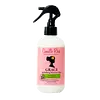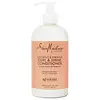What's inside
What's inside
 Key Ingredients
Key Ingredients

 Benefits
Benefits

 Concerns
Concerns

 Ingredients Side-by-side
Ingredients Side-by-side

Water
Skin ConditioningCetearyl Alcohol
EmollientCaprylic/Capric Triglyceride
MaskingCocos Nucifera Oil
MaskingCetyl Alcohol
EmollientStearyl Alcohol
EmollientBehentrimonium Chloride
PreservativeButyrospermum Parkii Butter
Skin ConditioningParfum
MaskingAloe Barbadensis Leaf Juice
Skin ConditioningHydrolyzed Vegetable Protein Pg-Propyl Silanetriol
Skin ConditioningHibiscus Rosa-Sinensis Flower Extract
HumectantSimmondsia Chinensis Seed Oil
EmollientMangifera Indica Seed Butter
Skin ConditioningMelia Azadirachta Seed Oil
EmollientBrassica Campestris Seed Oil
Skin ConditioningPanthenol
Skin ConditioningSodium Lauroyl Hydrolyzed Silk
Skin ConditioningTocopherol
AntioxidantGlycerin
HumectantGlycine Soja Oil
EmollientHydroxyethylcellulose
Emulsion StabilisingTriethyl Citrate
MaskingCaprylyl Glycol
EmollientBenzoic Acid
MaskingWater, Cetearyl Alcohol, Caprylic/Capric Triglyceride, Cocos Nucifera Oil, Cetyl Alcohol, Stearyl Alcohol, Behentrimonium Chloride, Butyrospermum Parkii Butter, Parfum, Aloe Barbadensis Leaf Juice, Hydrolyzed Vegetable Protein Pg-Propyl Silanetriol, Hibiscus Rosa-Sinensis Flower Extract, Simmondsia Chinensis Seed Oil, Mangifera Indica Seed Butter, Melia Azadirachta Seed Oil, Brassica Campestris Seed Oil, Panthenol, Sodium Lauroyl Hydrolyzed Silk, Tocopherol, Glycerin, Glycine Soja Oil, Hydroxyethylcellulose, Triethyl Citrate, Caprylyl Glycol, Benzoic Acid
Ingredients Explained
These ingredients are found in both products.
Ingredients higher up in an ingredient list are typically present in a larger amount.
Parfum is a catch-all term for an ingredient or more that is used to give a scent to products.
Also called "fragrance", this ingredient can be a blend of hundreds of chemicals or plant oils. This means every product with "fragrance" or "parfum" in the ingredients list is a different mixture.
For instance, Habanolide is a proprietary trade name for a specific aroma chemical. When used as a fragrance ingredient in cosmetics, most aroma chemicals fall under the broad labeling category of “FRAGRANCE” or “PARFUM” according to EU and US regulations.
The term 'parfum' or 'fragrance' is not regulated in many countries. In many cases, it is up to the brand to define this term.
For instance, many brands choose to label themselves as "fragrance-free" because they are not using synthetic fragrances. However, their products may still contain ingredients such as essential oils that are considered a fragrance by INCI standards.
One example is Calendula flower extract. Calendula is an essential oil that still imparts a scent or 'fragrance'.
Depending on the blend, the ingredients in the mixture can cause allergies and sensitivities on the skin. Some ingredients that are known EU allergens include linalool and citronellol.
Parfum can also be used to mask or cover an unpleasant scent.
The bottom line is: not all fragrances/parfum/ingredients are created equally. If you are worried about fragrances, we recommend taking a closer look at an ingredient. And of course, we always recommend speaking with a professional.
Learn more about ParfumTocopherol (also known as Vitamin E) is a common antioxidant used to help protect the skin from free-radicals and strengthen the skin barrier. It's also fat soluble - this means our skin is great at absorbing it.
Vitamin E also helps keep your natural skin lipids healthy. Your lipid skin barrier naturally consists of lipids, ceramides, and fatty acids. Vitamin E offers extra protection for your skin’s lipid barrier, keeping your skin healthy and nourished.
Another benefit is a bit of UV protection. Vitamin E helps reduce the damage caused by UVB rays. (It should not replace your sunscreen). Combining it with Vitamin C can decrease sunburned cells and hyperpigmentation after UV exposure.
You might have noticed Vitamin E + C often paired together. This is because it is great at stabilizing Vitamin C. Using the two together helps increase the effectiveness of both ingredients.
There are often claims that Vitamin E can reduce/prevent scarring, but these claims haven't been confirmed by scientific research.
Learn more about TocopherolWater. It's the most common cosmetic ingredient of all. You'll usually see it at the top of ingredient lists, meaning that it makes up the largest part of the product.
So why is it so popular? Water most often acts as a solvent - this means that it helps dissolve other ingredients into the formulation.
You'll also recognize water as that liquid we all need to stay alive. If you see this, drink a glass of water. Stay hydrated!
Learn more about Water